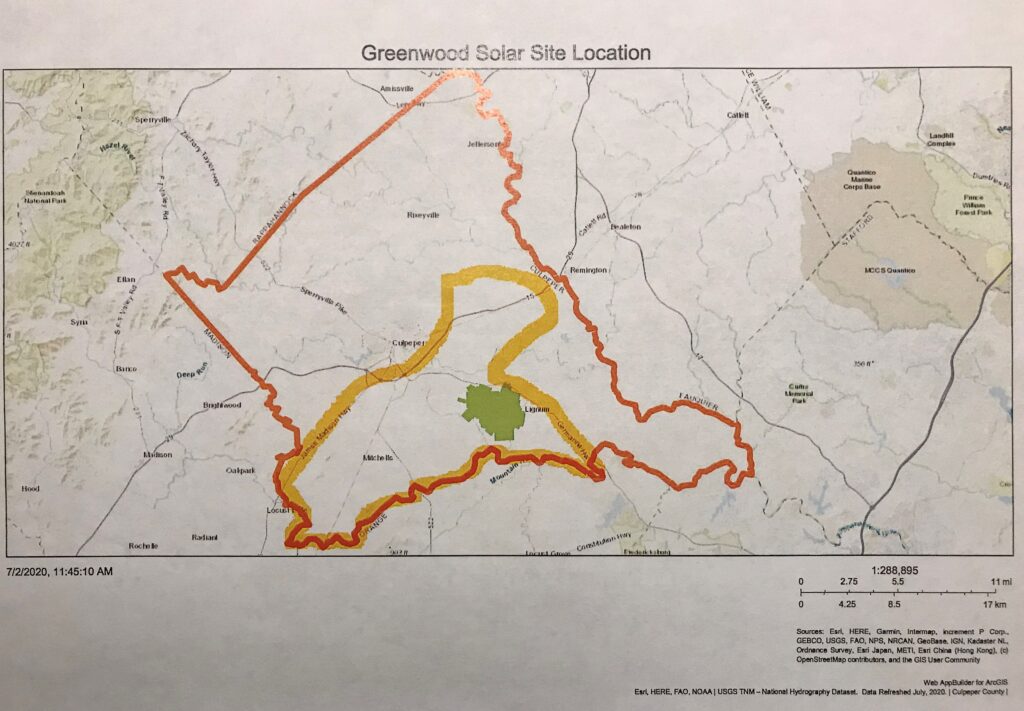In October 2018 the Culpeper County Board of Supervisors approved a proposal by Greenwood Solar, now a subsidiary of NextEra Energy, for a 1000 acre utility scale solar project. This industrial scale project is placed squarely in an area of historical significance to the Civil War, with Brandy Station battlefield to the north and Morton’s Ford battlefield to the south.
October 4, 2020 update to the information in this post: On October 2, the conditional use permit for Greenwood Solar expired. Greenwood Solar representatives asked the Culpeper Board of Supervisors for an extension, which thus far has not been considered at the Board’s subsequent meetings.
Update continued: There is a bill currently in the Virginia House that would grant a two-year extension to any projects with conditional use permits. It is not clear yet what the fate of that bill will be, or whether Greenwood will have recourse to continue to pursue their proposed solar project, which if built would be located in the area of historic study supported by a American Battlefield Protection Plan grant to FCMB. Our grant project is proceeding as planned; the consultants hired by FCMB to support the grant have begun their research work.
In October 2018 the Culpeper County Board of Supervisors approved a proposal by Greenwood Solar, now a subsidiary of NextEra Energy, for a 1000 acre utility scale solar project straddling Batna Road south of Route 3 in the county’s Stevensburg district. As of mid-July 2020, the 100 megawatt project is in the site plan stage of review by the Planning Commission as well as state Permit By Rule review.
This industrial scale project is placed squarely in an area of historical significance to the Civil War, with Brandy Station battlefield to the north and Morton’s Ford battlefield to the south. The project area and the Area of Potential Effect around the project area saw many troop movements and encampments, including the Winter encampment of more than 100,000 Union troops during 1863-1864. The project is bounded on one side by the Old Carolina Road, a historic byway dating to the pre-Colonial era. Notable properties adjacent include 19th century Rose Hill on the Virginia Landmarks Register and the National Register of Historic Places, and 18th century Salubria, also on the National Register of Historic Properties. Both are within the project’s Area of Potential Effect.
After being awarded an American Battlefield Protection Plan grant in May 2020 to study the Rapidan Front and winter encampment area where the project is planned to be located, FCMB’s board has come out strongly in opposition to the solar project. Installation of more than 300,000 solar panels will obliterate the cultural landscape, negatively impacting grant study efforts.
Since early May, the board of Friends of Cedar Mountain has communicated with the county Planning Commission, Board of Supervisors, Planning and Zoning director and town administrator to share the following:
- Our application for a grant to study the Civil War’s Rapidan Front including the 1863-1864 encampment.
- The awarding of the grant in the amount of $86,700.
- A map of our grant study area with a superimposed image of the Greenwood Solar project clearly showing the “integrity hole” the solar project would create in the solar project landscape.

In each of these communications the FCMB board asked for a stay on the project pending completion of the grant.
Board representatives also have attended two Planning Commission meetings. Board representative Karen Boushie was present at the Planning Commission’s July 8, 2020 work session on the project (no public comment period was available). She and board member Brad Forbush attended the Planning Commission’s August 12, 2020 meeting. In the public comment period during the August meeting, Boushie reviewed the board’s previous correspondence with the commission and again asked for a hold on the project until the grant can be completed. She also noted:
“Communications from Virginia’s Department of Historic Resources support a hold on Greenwood Solar to allow full pursuit of area study. We cite the DHR letter dated May 7, 2019 that responds to the solar project architectural survey. This DHR letter refers to 9 resources that “could contribute to a historic district that does not yet exist due to a lack of context studies.” Our grant will provide the needed context studies.
The same DHR letter also recommends additional surveys be done at a property at the Batna/Algonquin crossroads and at Mountain View Farm – these two areas also are within the scope of our grant.”
In her comments, Boushie also asked for confirmation that the Commission had received the cultural assessment that is part of the developer’s permit by rule application, saying, “A reading of this report confirms that the area merits the deeper research that our grant will support.”
Board member Brad Forbush submitted a statement via email. His email was misplaced by the Planning and Zoning office and will be read into the record at the Commission’s September meeting. In a brief statement, Forbush reviewed the widespread interest in Culpeper’s history as evidenced by the number of tours he gives to visitors from many different states. These include, California, Hawaii, Kansas, North Carolina, Massachusetts, Vermont, New Hampshire, Pennsylvania, and of course, Virginia.
Anyone who would like to send a comment about the project to the Planning Commission before their next meeting on September 9 may do so by following these instructions for email, voicemail and postal mail submissions.

